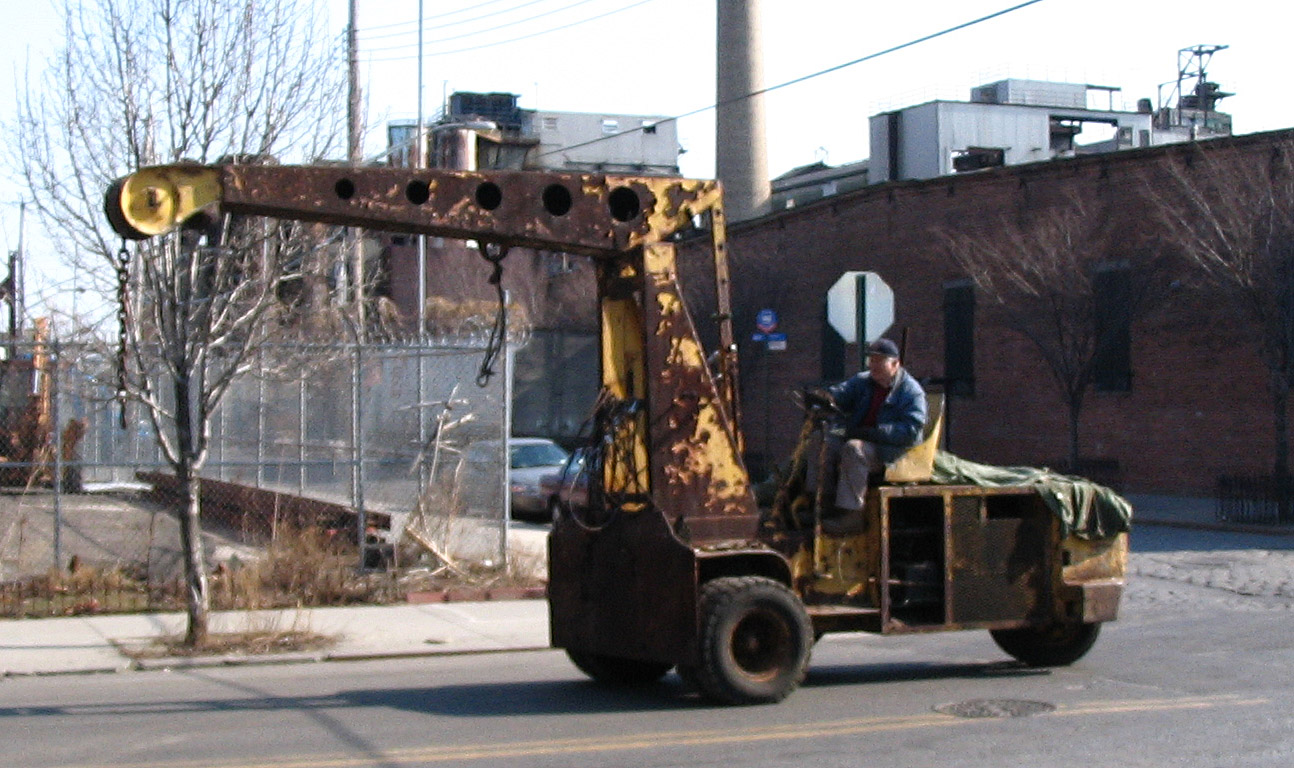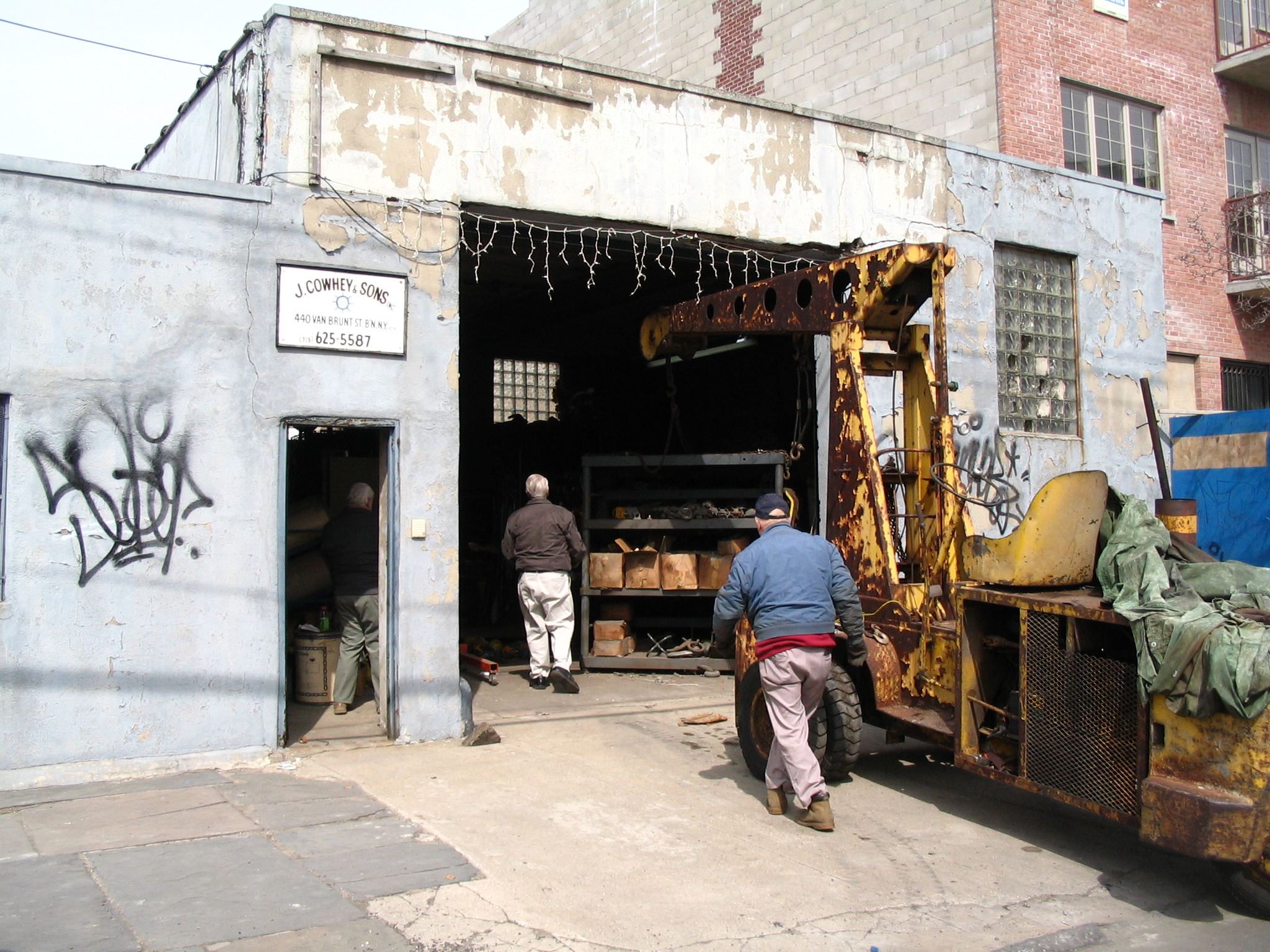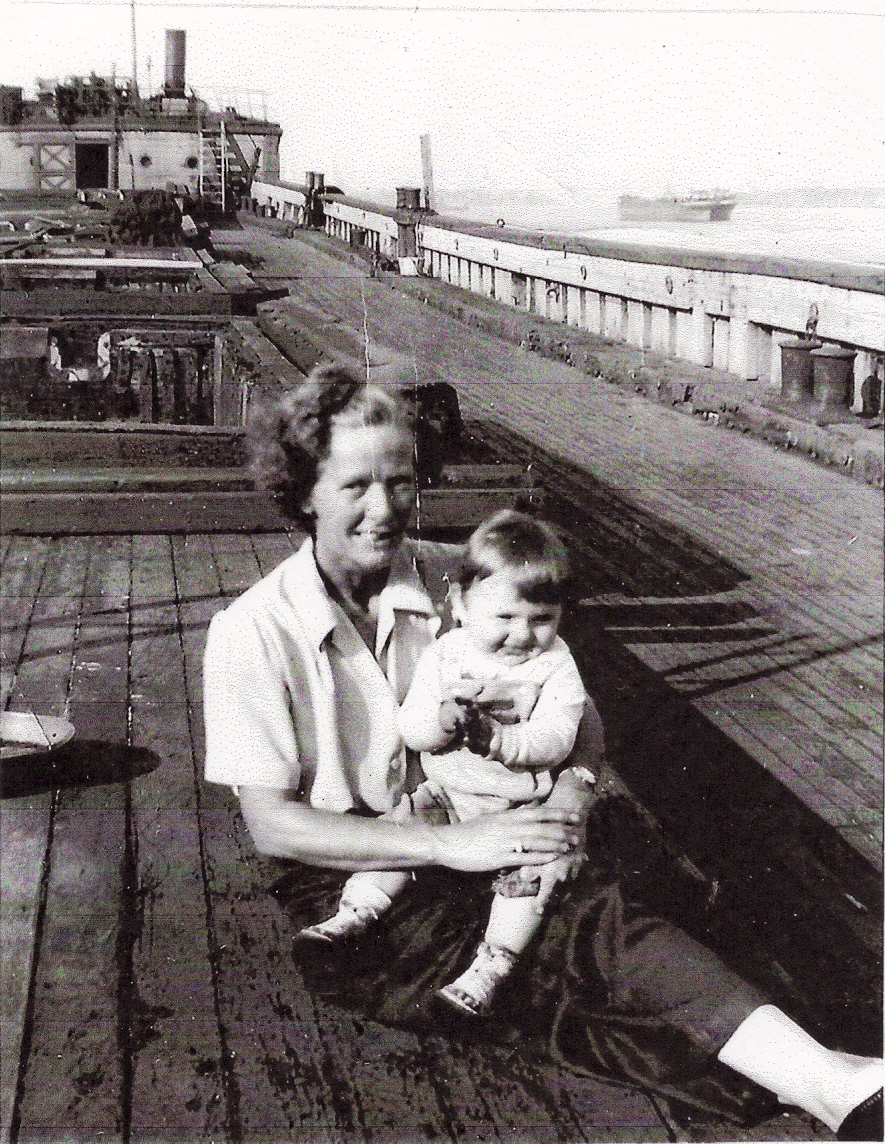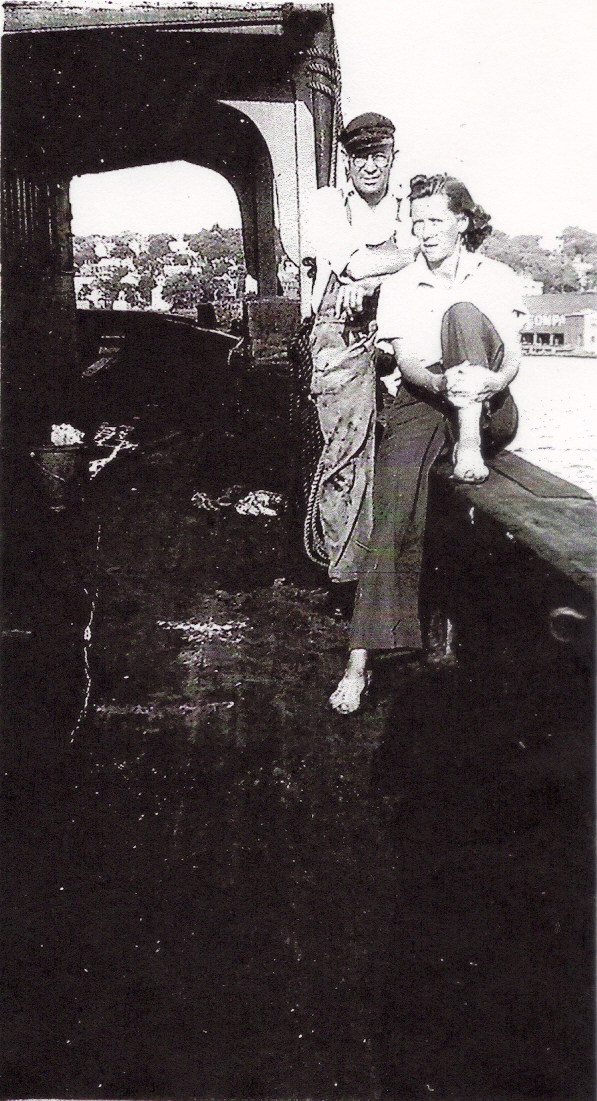PortSide NewYork Hyster eligible for National register of Historic Places - updated 6/3/20
/2020 update
Have you got experience repairing a 1941 Hyster Karry Krane? We could use your help! We expect to get a 1941 Fairbanks Morse engine from Kennett, Missouri in July, so we are interested in repairing our 1941 Hyster Karry Krane in order to have a crane to use to lift parts off that engine preparatory to bringing them aboard our ship MARY A. WHALEN. We will be using parts from the 1941 Kennett engine to restore the 1938 Fairbanks Morse engine in the MARY. Below is an edited version of our 2013 blogpost about our Hyster.
Our manual for the 1941 Hyster Karry Krane is here.
Another triumph! Another historic item for Red Hook! Our Hyster crane (built in 1941) has been deemed eligible to be on the National Register of Historic Places! and in record time~
What triggered this accomplishment
In just two days, our Historian/Curator Peter Rothenberg researched the history of our 1941 Hyster and the history of this "Karry Krane" model, submitted an application to SHPO (the NYS Historical Preservation Office) to see if it was eligible to be listed on the National Register of Historic Places, and got that application approved!
We profusely thank the staff at SHPO for reviewing our application in just hours, and we also profusely thank Jenny Bernstein of FEMA who told us about the grant that prompted us to focus on the Hyster. The Hyster was flooded by Sandy, and the grant is for Sandy damage to historic and cultural resources.
PortSide applied for funding to reverse Sandy damage to the Hyster and to the replacement parts for MARY A. WHALEN's engine which were in the shed. The grant does not cover damage to historic documents which were flooded by Sandy.
We applied for for the Hyster, and for damages to MARY's engine parts we would use. (The grant would not cover damage to those engine parts we planned to sell to support the restoration of the MARY A. WHALEN's engine.) Earlier this year, we applied for FEMA Sandy recovery funds for Sandy damages, but we do not yet know if we will get funding. We did not apply until May 2013 because we were told in a November 2012 funding workshop that we were not eligible; that was corrected in May, at which point we immediately sought Sandy recover funds.
Crash course into the National Register of Historic Places
In short, getting on the National Register of Historic Places is a two-stage process: being "deemed eligible" and actually being listed. PortSide did the MARY A. WHALEN in two steps. For something to be on eligible or listed, it has to be deemed historical significant in some or all of the following ways:
Is it associated with an important person, event, or movement in history? Does it represent a significant design or technology, or is it a special example of a particular style? Is it the work of a recognized master? Could it yield important archaeological information about our past?
Here is our full application to SHPO in two parts.
Determination of Eligibility (DOE) for listing on the National Register
Supplemental History of Michael Cowhey
SHPO's response was "Thank you for pulling together this very compelling and fascinating history of the "Karry Krane" in such a short amount of time! Both myself and my colleague, Kath LaFrank of our NR Unit, have reviewed your submission and, based on the information provided, the Hyster "Karry Krane" is eligible for the State and National Registers of Historic Places. The only other somewhat similar type of property in NYS that we've called eligible is a historic steam shovel in LeRoy, NY. "
We copy excerpts from our DOE application below.
Todd Shipyard boomed during WWII. There were mobile cranes like ours in use at Todd. We have yet to check if the grain terminal used them.
The successor to our 1941 Hyster are the many forklifts used all over Red Hook.
History In brief
The “Karry Krane” name was first used July 14, 1941. PortSide’s Crane is from 1941. PortSide’s crane is both one of the original Karry Kranes made and, while once common, is now one of the last of its kind.
This crane type was developed by Hyster during WWII and was very significant to the war effort here and overseas. It was used in shipbuilding facilities, in ports for cargo handling and for rebuilding after the war effort. It was such a useful vehicle that Hyster produced it overseas when it opened its first plant outside the USA in 1951. It became an international workhorse. We find documentation that shows it was used in New Zealand in addition to Europe.
This particular Hyster crane was last used by Cowhey Brother Marine Hardware in Red Hook which closed in 2005 and donated their final inventory to PortSide NewYork. The Cowhey family was in several forms of maritime business in Red Hook for about 140 years when three Cowheys wound down the business.
Cowhey’s bought the crane from the Staten Island Bethlehem Steel shipyard when that closed in the 1960s. We presume that the crane was new when purchased by Bethlehem Steel when that yard boomed during the war effort.
Physical description of the crane
The crane dimensions are:
Body length 12’ 4”
Length of boom 10’ 1”
Overall length 22’ 3”
Height of body 3’ 3”
Height of boom 10’ 8”
1940: By experimental use of tractor frames, an advanced type of mobile crane is developed, later named the “Karry Krane."
1952: Hyster opens its first plant outside the USA, in Nijmegen, the Netherlands. The Hyster 40” and the Karry Krane are the first machines to be assembled there.
Criteria for evaluation.
This 1941 Hyster Karry Krane meets the following National Regsiter criteria:
(a) that are associated with history of a prominent Red Hook family and business. It is the last sizeable artifact of that business. It is related to a collection of other artifacts we have for that business. This particular crane is related to maritime history of NYC (two sites, one in Red Hook, one in Staten Island). And the crane model is particularly related to WWII history everywhere this crane became a major workhorse
(d) that have yielded, or may be likely to yield, information important in prehistory or history. It is a means to tell stories related to the Cowhey family and business in Red Hook, the Bethlehem Steel shipyard in Staten Island, WWII and reconstruction operations in civilian and military applications.
History of the Hyster company
This is a 2.5 ton Hyster,the most popular World War 2,dock, lift and carry crane.they first came over on lease lend in 1941.
COLLECTION HYSTER KARRY KRANE MOBILE CRANE USAF USNAVY WWII
Establishing Willamette Ersted Co.
The company that would be known as Hyster Co. was founded by E.G. Swigert in 1929 under the name Willamette Ersted Co.[2] Initially, this company was established to manufacture logging winches for the forestry market in the Pacific Northwest, with headquarters in Portland, Oregon.
The Early Products
1934 saw the development of the straddle carrier with forks, which was one of the company’s earliest forklifts. Following this was the development of the BT, a forklift with a cable hoist system, able to lift 6,600 pounds (3,000 kg).[3] By 1940, the company began to manufacture its first piece of mobile lifting equipment, a mobile crane on a tractor frame, first known as a Cranemobile, later to be renamed Karry Krane. The Karry Kranes would prove to be very profitable for the company, as these lift trucks were used for loading and unloading massive cargo ships for importing and exporting purposes. In 1941, Willamette Ersted began recognizing a need for a smaller lift truck, and designed a new smaller model known as the Handy Andy. The following year, the Jumbo was introduced as the company’s first product to use pneumatic tires and a telescoping mast.
Operations in Peoria
In the company’s early years, one of its prominent customers was Caterpillar Tractor Co. Caterpillar held an exclusive contract with the company, whereby Willamette Ersted Co. would manufacture specialized winches for Caterpillar’s logging tractors. In light of this, the company decided in 1936 to open a warehouse and distribution center in Peoria, Illinois, where Caterpillar was headquartered. By 1940, Willamette Ersted Co. had begun full-scale manufacturing of products at its Peoria location.
For more info check out... http://www.ritchiewiki.com/wiki/index.php/Hyster_Co.
History of the Cowhey family and their business in Red Hook
The story of this business is a means to cover several topics: how an immigrant family rises in stature, the growth of a marine business from “speculator” (eg, the maritime version of the scrap collectors with shopping carts today, someone who collected scrap metal by going boat to boat in the harbor), to a purveyor of nautical antiquities to the wealthy, then a marine hardware supplier and the operator of a port in Albany.
The Cowhey family grew in prominence in Red Hook from their speculator days in the 1860s, and at the peak of the business, they owned most of a block in the vicinity of their final outpost at 440 Van Brunt Street.
In 2005, as the business wound down, the Cowhey family operated a terminal in Albany of Federal Marine Terminals http://www.fmtcargo.com/.
Chronology of Cowhey family in Red Hook (for more, see attached history about Michael Cowhey)
John Cowhey started his business about 1862 [1937 obit says business started about 75 years ago]
By the time his son Michael Cowhey was running it, the business, John Cowhey Sons at 400 Van Brunt was a ship wrecking and salvage firm. The company was well known to decorators looking for nautical articles.
John Cowhey was famous for purchasing in 1911 the RELIANCE a racing yacht which one the America’s cup, dismantling her and selling her fittings and scrapping her parts. The 110-foot mast went to the Federal Baseball League park.
Michael Cowhey. d. 1937 had a wife Regina [or Margret according to a different source], a daughter Regina and two sons Thomas and John.
Thomas M. Cowhey in 1990 was the title holder to 440 Van Brunt which was built c. 1931, altered in 1957.
A Brooklyn Daily Eagle, Jan. 20, 1931 article describes John Cowhey as "one of the influential citizens of Red Hook" in his day.
The same article tells that Michael had in his yard several large old church bells that he had bought for scrap but had decided to hold on to. The bells rang eerily in the night but:
"If some one suggested that the ghost of an old Bailing ship skipper might be behind the tolling, he would nod solemnly. Then he would ask if his questioner had ever heard how in 1880 the wind blew so hard that Red Hook was white with scales, blown clean off the harbor fish, and how all the houses on the Hook had to be held in place by anchors. And how once it was so cold that he, Michael Cowhey, was able to walk barefooted over the ice to Staten Island. "



















